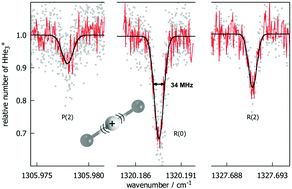Spectroscopic signatures of HHe2+ and HHe3+†
Abstract
Using two different action spectroscopic techniques, a high-resolution quantum cascade laser operating around 1300 cm−1 and a cryogenic ion trap machine, the proton shuttle motion of the cations HHe2+ and HHe3+ has been probed at a nominal temperature of 4 K. For HHe3+, the loosely bound character of this complex allowed predissociation spectroscopy to be used, and the observed broad features point to a lifetime of a few ps in the vibrationally excited state. For He–H+–He, a fundamental linear molecule consisting of only three nuclei and four electrons, the method of laser-induced inhibition of complex growth (LIICG) enabled the measurement of three accurate rovibrational transitions, pinning down its molecular parameters for the first time.



 Please wait while we load your content...
Please wait while we load your content...